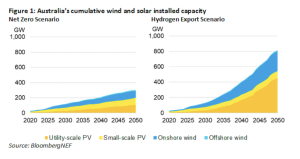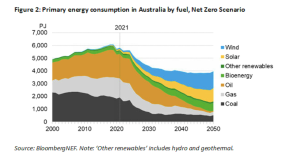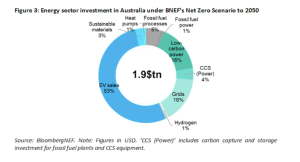BloombergNEF report: Australia Needs 800 Gigawatts of Solar and Wind to Meet its 2050 Net-Zero and Hydrogen Export Ambitions
Sydney, May 23, 2023 – Australia’s transition to a net-zero economy represents at least a USD$1.9 trillion investment opportunity in the country’s energy system by 2050, according to the New Energy Outlook: Australia report, published today by research company BloombergNEF (BNEF). The report details three future scenarios for Australia’s energy systems and also highlights the impacts of Australia’s aspirations of becoming a clean hydrogen superpower.
Power sector decarbonisation is the key to unlocking opportunities in Australia’s energy transition
Australia’s power sector is its biggest source of carbon emissions today, but it will play a pivotal role in the country realizing a net-zero economy. BNEF’s modeling finds that rapid scaling up of investment in wind and solar power, along with deploying a new fleet of low-carbon back-up capacity, is the cheapest way for Australia to reduce emissions. In BNEF’s Net Zero Scenario, wind and solar installations reach 300 gigawatts by 2050, up from 39 gigawatts in 2022. Solar capacity alone would reach 201 gigawatts of installed capacity by 2050, split between rooftop systems and large-scale projects.
BNEF’s Hydrogen Export Scenario shows that Australia can meet its own net-zero targets while also supplying as much as 6%, or 28 million metric tons per year, of expected global low-carbon hydrogen demand in 2050. This would require electricity generation to grow to 1,963 terawatt-hours by 2050, seven times more than today. This electricity demand would be 169% more than in the Net Zero Scenario. To supply this demand on a least-cost basis, wind and solar capacity across the country would need to grow to 812 gigawatts by 2050, 21 times more than today. Most of the electricity produced by these plants would be used to produce hydrogen via water electrolysis.

Investment in Australia’s generation fleet between 2022 and 2050 exceeds $413 billion in the Net Zero Scenario, with 57% expected to flow into wind and solar assets. In the Hydrogen Export Scenario, power generation investment balloons to $739 billion by 2050, representing a $594 billion investment opportunity in wind and solar.
“Australia stands at the cusp of the biggest transition in its power system, ever” said Tushna Antia, Australia Renewables Analyst at BNEF. “An abundance of high-quality and low-cost renewable energy resources gives Australia a real advantage in its journey to net zero, but the right policies and market settings will be imperative for orderly transition.”
Scaling new technologies will be crucial in getting Australia to net zero
Australia’s transport sector will also play a key role in achieving net zero. In the Net Zero Scenario, improving economics and additional policy support will drive electric vehicles’ share of new passenger vehicle sales up from just under 4% in 2022 to 100% by 2032. In addition to electrification, Australia will need to develop new supply chains for sustainable fuels and stronger policies enforcing energy efficiency to decarbonize its transport sector by 2050.

The analysis also shows that new technologies, such as carbon capture and storage (CCS) as well as low-carbon hydrogen are essential in decarbonizing Australia’s hard-to-abate sectors, especially heavy industry. The Net Zero Scenario sees CCS capacity for domestic market usage peak at around 55 million tons per year by 2050. Hydrogen is a critical technology in applications where it is unfeasible or uneconomic to electrify. In the Net Zero Scenario, clean hydrogen production to meet domestic needs rises to around 3.7 million metric tons by 2050. In the Hydrogen Export Scenario, this figure soars to around 28.5 million metric tons.
“Hydrogen will play a pivotal role in Australia’s own decarbonization ambitions as well as green export ambitions.” said Sahaj Sood, Australia Energy Transition Analyst at BNEF. “However, a lack of concrete clean hydrogen import demand together with significant transportation challenges stand in the way of Australia’s hydrogen export ambitions.”
Australia needs to accelerate low-carbon investments
Investment in Australia’s energy sector and low-carbon technologies will need to scale up rapidly, for the country to reach its net-zero ambitions. Between 2022 and 2050, over $1.9 trillion will need to be invested, with 95% flowing into low-carbon technologies or supportive infrastructure.
Electric vehicles represent the single largest investment in low-carbon technologies, totaling $1 trillion by 2050 under BNEF’s Net Zero Scenario, while low-carbon generation sources see $391 billion in investment.
BNEF’s Net Zero Scenario also finds that an annual average of grid investments of $11 billion is needed, a far higher rate than Australia is currently investing in its grid, to ensure a reliable energy system.

Fossil fuels will still play an important role in Australia’s economy for years to come. However, for every $1 Australia invests in fossil fuel supply between 2022 and 2050, it will need to invest $6 in low-carbon energy sources, if it is to reach its net zero goals.
“Australia has fought hard over recent years to change the global perception of the country as a climate laggard.” said Leonard Quong, head of Australia Research at BNEF. “But the country will need to reform existing policies and energy-market design to accelerate investment in both technologies and workforce needed for the transition – if it is to realize the low-carbon opportunities that lay ahead.”
The inaugural BNEF Forum Sydney on June 7 will further explore the findings of this report.
This research forms part of a series of regional and sector reports diving deeper into results from BloombergNEF’s global New Energy Outlook report. BloombergNEF will publish further regional reports for China, the US, Japan, and India over the coming months. Report summaries are available at about.bnef.com/new-energy-outlook-series.
Contact
Oktavia Catsaros
BloombergNEF
+1-212-617-9209
ocatsaros@bloomberg.net
About Bloomberg
Bloomberg is a global leader in business and financial information, delivering trusted data, news, and insights that bring transparency, efficiency, and fairness to markets. The company helps connect influential communities across the global financial ecosystem via reliable technology solutions that enable our customers to make more informed decisions and foster better collaboration. For more information, visit Bloomberg.com/company or request a demo.